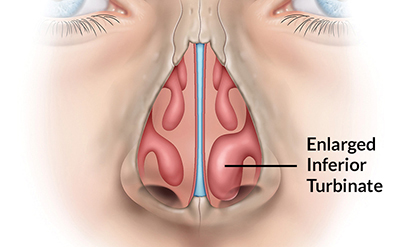Turbinate Hypertrophy

As an experienced otolaryngologist, Dr. Seejo George specializes in diagnosing and managing this condition, helping patients find relief and improve their nasal function.
Understanding Turbinate Hypertrophy:
Turbinate hypertrophy refers to the enlargement or swelling of the nasal turbinates. These structures are tiny, bony protrusions on the inside of the nose that help filter, warm, and moisturize the air we breathe. When they become enlarged, they can obstruct the nasal passage, causing various symptoms and affecting nasal airflow.
Common Symptoms of Turbinate Hypertrophy:
Patients with turbinate hypertrophy often experience the following symptoms:
1. Nasal Congestion: Enlarged turbinates can obstruct the nasal passage, leading to chronic nasal congestion. This may cause difficulty breathing through the nose, especially during sleep or physical activity.
2. Reduced Sense of Smell and Taste: The swollen turbinates can impair the ability to fully smell and taste food, leading to a diminished quality of life.
3. Postnasal Drip: Excessive mucus production can result from turbinate hypertrophy, leading to a persistent sensation of mucus dripping down the back of the throat.
4. Facial Pressure and Headaches: The congestion caused by enlarged turbinates can lead to facial pressure and recurrent headaches.
Treatment Options for Turbinate Hypertrophy:
Dr. Seejo George offers comprehensive treatment options to address turbinate hypertrophy, tailoring each treatment plan to the patient's specific needs. Some common treatment options include:
1. Medical Management: Medications, such as nasal decongestants, antihistamines, or nasal steroid sprays, may be prescribed to manage symptoms and reduce turbinates' swelling.
2. Turbinate Reduction Procedures: If medical management is not effective, Dr. Seejo George may recommend turbinate reduction procedures. These procedures aim to reduce the size of the turbinates while preserving their vital functions. They may include submucosal resection, radiofrequency ablation, or turbinate reduction surgery.
3. Nasal Steroid Sprays: For milder cases, the use of nasal steroid sprays may be sufficient to manage symptoms and reduce inflammation.
Compassionate Care for Nasal Health:
Dr. Seejo George understands the impact that turbinate hypertrophy can have on your daily life and overall well-being. With his expertise and compassionate approach, he is dedicated to providing personalized care to each patient, ensuring their comfort and satisfaction.
If you are experiencing symptoms related to turbinate hypertrophy, we encourage you to schedule a consultation with Dr. Seejo George. He will conduct a comprehensive evaluation, discuss treatment options, and create a customized plan to help you find relief and achieve optimal nasal function.
Contact us today to schedule a consultation and take the first step toward improving your nasal health. Together, we can find a solution for your turbinate hypertrophy and help you breathe freely again.






